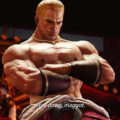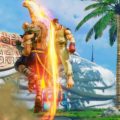Special Feature: 20 Years of Street Fighter III: 3rd Strike

The Street Fighter III series was a significant risk on Capcom’s part, the kind we no longer see in the fighting game (and overall video game) development arena as a whole. The series started with Street Fighter III: New Generation, the title that reset the cast outside Ryu and Ken and gave all the characters some of the most detailed and animated sprites in gaming history. (Ryu and Ken almost didn’t make it in initially, until Capcom figured it would be too risky to leave them out.) There was no way they could profit off one game with sprites this detailed, which led to the existence of Street Fighter III: 2nd Impact, which added Hugo (related to Final Fight’s Andore family) and Akuma.
The series reached its zenith with Street Fighter III: 3rd Strike, the most remembered game of the three. Here, the cast reached a robust point, despite how its 18-character cast seems low by modern standards. It included several characters with distinguishable move sets to accompany its deep gameplay, along with a timeless presentation. It’s been 20 years since the title released, and it thankfully hasn’t been forgotten by the fighting game community. Even so, there isn’t a better time to remember it.

While 3rd Strike is one of the most popular installments in the franchise, it wouldn’t be correct to say it always held that status. Upon its release in arcades in May 1999, its reception was comparable to previous SFIII titles. It was appreciated by some big Street Fighter fans, but others who felt previous SFIII games didn’t compare to the best Street Fighter II titles didn’t give it much of a look. This was also the case after it received a Dreamcast port in 2000, though it wasn’t arcade-perfect. It wasn’t until after Capcom had moved on from SF games and overall fighting game development when several fans who shunned it realized how good it was. This happened around 2002, and fans discovering the game’s qualities led to its current popularity after initially being neglected.
The concept of nearly rebooting the cast was unappealing for many fans at first, but the new characters grew on them after dedicating time to the game thanks to their unique move sets and personalities. Characters like Ibuki, Necro, Alex, Urien, Q, and Makoto were unique in their appearances at the time compared to those in previous SF games and in fighters as a whole. Several have since starred in some SF progeny, but they’ll always be most remembered for the games they debuted in.
It’s impossible to talk about SFIII’s characters without delving into how beautiful and detailed the sprites are in motion, and the personality they exude. There are enough examples that an entire post could be made from them alone, but several stand out among them. Elena’s main fighting stance is one of the best examples, closely followed by one of her win animations, where Capcom’s sprite animation team was assisted by good rotoscoping. Makoto’s walking animation is also a good one. Others show good personality, like the unique intros for Ryu and Ken, Alex and Hugo (a nod to the legendary wrestling bout between Hulk Hogan and Andre the Giant), and Makoto and Ibuki. The sprites are a labor of love, and we’ll never get another fighting game with sprite animations this good again unless it has around six characters.

All those sprites wouldn’t have meant anything if they weren’t attached to a deep and rewarding game, which fortunately is the case for 3rd Strike. It contained a good helping of traditional and special attacks per character, and Super Art special techniques that could be chosen from the character select screen.
The most unique function to this game involved parrying, where each character could use a special defensive maneuver by quickly tapping a joystick or directional pad towards their opponent when timed with an attack. The timing is very strict, but parrying involves no pushback, contains shorter recovery time compared to blocking, and causes no chip damage. With how tough the timing is, learning when to parry and the window to counter after an attack is parried is a good part of what made this game tough to learn to an intimidating degree. And that’s not getting into other features, like choosing which Super Art best fits each player’s style for each character, and the unique combo timing in general. But it’s a fun experience for anyone willing to put in the time.
The infamous bout between Daigo Umehara and Justin Wong from Evo 2004 best shows how the game is played at an expert level, which gave birth to Evo Moment 37 at the end. An extended version of this tournament battle was uploaded a mere month ago, as if in preparation for this anniversary. Parrying Chun-Li’s Super Art is considerably harder to do than it looks, and takes hours upon hours of practice — especially in the heat of the moment.

It’s tough to talk about 3rd Strike without discussing its great soundtrack. The first two SFIII games contained a fusion of jazz and New Age tracks, but this game embraced the hip-hop genre, which worked incredibly well with the game’s style. The results are often good when Capcom gives the characters original tracks instead of reusing themes from previous games, despite how some characters have the same theme here (see Ken and Alex have, Necro and Twelve, and Sean and Oro). It’s circa late-90s hip-hop, but the overall soundtrack has aged better than those from several other fighting games, especially the remixed version.
Street Fighter III: 3rd Strike is well worth remembering thanks to how Capcom perfected the SFIII formula here, and how no developer will ever make a game that both looks and plays quite this good again. Fortunately, Capcom has provided good ports across several console generations, so the game should be preserved without the need for retro aficionados to step in for years to come.





